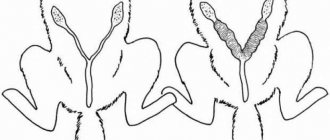Rabies in dogs is a fatal disease that affects warm-blooded animals. A pet can become infected with this viral disease from stray animals that have been in contact with wild relatives infected with the rabies virus.
The virus is transmitted through a bite or when the saliva of a sick animal gets into the open wound of a healthy dog. The disease is classified as incurable, and in order to avoid the death of a pet, the disease should be prevented with timely vaccination.
What kind of disease is this
It has many names: hydrophobia and hydrophobia. But the fact remains: rabid dogs are incurable and highly contagious, which means they are deadly to others. This is an acute viral disease that occurs in an animal or person after being bitten by a sick dog. His symptoms are completely unique. First of all, damage to the central nervous system is observed, the sick person or animal becomes excitable, and in parallel, a fear of water develops, as well as paralysis of the respiratory muscles and limbs. Mad dogs, like people affected by the disease, are incurable, but until their death they remain a source of infection for others.
What is the disease
Rabies, a disease caused by a specific deadly virus, is one of the oldest infectious diseases. An acute viral disease affects the nervous system and can be transmitted to all animals and even humans. Rabies in dogs is dangerous because these types of animals communicate closely with humans and can cause infection.
The hydrophobia virus is resistant to phenols, antibiotics and freezing. It is destroyed under the influence of acidic and alkaline environments, as well as when heated above 57 degrees for 15 minutes.
How can a dog become infected with rabies? Rabies is very common among homeless and stray animals. Pets become infected from direct carriers of the viral infection, becoming a focus of infection in a place where there is a large concentration of domestic animals and people. The greatest danger of contracting this type of virus is the long period of the latent phase.
Note! The rabies virus can remain dormant for 3 months without showing its virulence.
How is rabies transmitted in dogs? The zoonotic infection is transmitted through the bites of an infected animal and contaminated saliva. Typically, the first signs of infection appear already 3 weeks after infection. Viruses in the saliva of an infected dog can be detected 6-12 days before the onset of the first characteristic clinical signs.
A possible route of transmission is associated with the contact of saliva of a sick animal on open wound surfaces, as well as other damage to the skin and mucous membranes. Bites that were inflicted on the muzzle and front paws are especially dangerous. Transmission of the virus can occur during a period when the infected animal does not yet have characteristic clinical symptoms. Other types of infection and transmission of the deadly virus are:
- nutritional – through water and food products;
- airborne;
- through the feto-placental barrier - from mother to fetus.
Note! In small puppies, the disease begins to manifest itself within 7 days after contact or bite by an infected animal, but in adult pets, a latent course can occur for a very long time - up to 1 year.
Read more about the rabies virus in the veterinary reference book.
Prevalence of the disease
Many people think that due to the availability of vaccines, the incidence rate today is quite low. In fact, this is not the case; it’s not for nothing that rabid dogs (you’ve probably seen the photo in the newspapers) are still considered threat No. 1. Today, outbreaks of this terrible disease are observed everywhere. There are no vaccinations in the wild, which means that rabid foxes and wolves periodically emerge from the forests, where they can meet stray animals. Therefore, this problem cannot be solved only by catching stray dogs. The very bad thing is that the disease has a long incubation period, during which the animal is already potentially dangerous. Most often this is 3-6 weeks, but often this time extends to one year. Throughout this period, the animal’s saliva is deadly.
Can rabies be cured?
The disease is classified as incurable. They have been trying to find a cure for it for about half a century, but so far to no avail. The first evidence of rabies patients appeared in the sixteenth century. Since then, a vaccine against this deadly virus has been developed. It was created by a microbiologist from France, Louis Pasteur, in 1885. A cure for lyssavirus began to be invented only in the twenty-first century. It is an artificial coma into which an infected patient is placed.
This method was tested in 2005 on American Gina Gies. She was put into an artificial coma and given immunomodulators. After a week of this condition, the woman began to recover. This technique was tried several more times, but cure occurred only in isolated cases. Based on the experiments, the doctors decided that the recovered patients were infected with abortive rabies, so their method had nothing to do with it, since the patients recovered on their own.
This method has not been tested on dogs. Not only because the treatment is expensive, but also because no one wanted to try the technique on their dog. In addition, vaccinations against this virus, which are given to pets, save the situation. Vaccinating a dog against rabies allows your four-legged friend to develop immunity to the virus and not get sick even if bitten by a rabid dog.
Violent form of the disease
This is exactly what we think of mad dogs as. A photo of a dog frantically tearing at its chain with foam at its grinning mouth immediately evokes a strong association with this disease. In reality, everything is not so simple. At the very beginning of the development of the disease, the animal avoids people, becomes lethargic and reluctant to carry out the simplest commands, often hides in dark places and eats poorly. Already at this stage you should suspect that there is a mad dog in front of you. Symptoms will develop day by day: apathy will be replaced by anxiety, irritability and fearfulness. The dog barks, looks around, rushes about, reacts extremely painfully to turning on the light or shouting. Begins to show aggression, the slightest noise provokes an attack of rage.
A feature of this disease is complete refusal of food. But at the same time, the dog greedily swallows inedible foods. The sick animal is furiously gnawing at the bite site, and you can observe a spasm of the pharyngeal muscles: the pet cannot swallow water. In the next stages of the disease, the animal salivates profusely, the barking becomes hoarse, often turning into a howl. And the riot is replaced by a state of oppression and powerlessness, but any noise again provokes rage.
Origin
Since ancient times, rabies has been considered the most serious and dangerous, fatal disease in animals. Nowadays, people have learned to counteract this infection and have invented vaccinations. After all, this is a disease that can be transmitted from animals to people. A rabid dog itself can be a carrier of the disease, but show no signs. Therefore, pet owners should definitely know more information about this disease.
Rabies is a well-known and oldest infectious disease. It is transmitted to animals and humans by affecting the nervous system. If your pet is not vaccinated against rabies, then there is a high risk of contracting this disease from other carriers of rabies upon contact with them.
The last stage of the violent form
So, God forbid, of course, it’s already clear to you that you have a mad dog. What to do? The most humane thing to do would be to euthanize the animal, thus ending its suffering. There is no healing. Very soon the pet will lose its voice and become exhausted. The lower jaw droops, and paralysis is now obvious. Saliva flows profusely, the tongue falls out, the corneas become cloudy. Further paralysis will begin to cover the entire body, limbs, and internal organs. This torment lasts from 3 to 11 days. The bite of a rabid dog, like just saliva, is fatal, so if you suspect that your animal is sick or a dog with similar symptoms appears near your house, you should immediately call a special veterinary service. In different cities these may be different units, but most often they work at the city veterinary clinic.
Vaccinations
Rules for rabies vaccination of dogs in Russia
There is a vaccination schedule for dogs, which indicates the recommended age of the animal.
Sometimes the vaccination date is postponed on the recommendation of a veterinarian for some reasons, for example, cropping of ears, weakened immunity, or change of teeth in a puppy.
Complex vaccine
There are mono-vaccines that protect against one disease, and poly-vaccines - complex preparations that form immunity against several diseases at once.
Polyvaccines are most often used for adult dogs to support already developed immunity.
Where to do it?
Vaccination of animals is carried out in any veterinary clinic.
If there are no contraindications at the moment, vaccination is carried out on the same day according to the instructions for the drug.
Free vaccination
On the territory of Russia, vaccination is free and mandatory for all dogs in regions affected by the epizootic situation of rabies.
Vaccination is carried out in state veterinary clinics and vaccination centers.
How to prepare your dog for vaccination?
Only healthy animals are vaccinated. A week or two before the expected date of vaccination, deworming is carried out - treatment for possible helminthic infestations.
Animals infected with worms are not allowed to receive vaccination.
When to do it?
According to the vaccination schedule for dogs, the first vaccination is carried out in puppies at the age of three months - preferably before the first change of teeth.
Sometimes, for health reasons or on the recommendation of a veterinarian, vaccination is postponed for up to six months.
If vaccination is carried out before three months of age, re-vaccination is carried out after two to three weeks for a more stable formation of immunity
. For older puppies, one vaccine is enough.
How long does it last?
On average, a dog's immunity lasts for a year.
Expensive drugs can provide longer-lasting immunity. It weakens over time, so annual booster vaccination is recommended.
How often to repeat?
Revaccination is carried out every year, at approximately the same time, coinciding with the first vaccination by month.
Sometimes, depending on the drug used, revaccination is carried out every two to three years.
Contraindications
On the day of vaccination, the veterinarian must examine the animal for contraindications. If the dog has an elevated body temperature, helminthic infestations, or the dog looks sick or exhausted, vaccination is postponed.
Contraindications include recent injuries and weakened immunity.
How to do it yourself?
You can vaccinate a dog yourself, but in this case you will not be able to enter information about the procedure into the veterinary passport.
It is recommended to carry out this procedure in a veterinary clinic. The doctor can choose the right drug and the required dose.
Where is the injection given?
Most anti-rabies injections are given intramuscularly in the thigh area.
It is possible for some drugs to be administered subcutaneously into the withers area. Information on the rules for administering the drug is in the instructions for use.
Vaccination for an adult dog
If the dog was not vaccinated as a puppy, vaccinating it is not only acceptable, but also desirable.
Adult animals tolerate the first vaccination a little more difficult. However, it is easier to endure minor side effects from vaccination than to euthanize a sick animal.
Puppy
Puppies tolerate vaccination quite easily, side effects depend on the type of vaccine
and individual characteristics of the animal. The first vaccination is recommended for puppies.
Old dog
The vaccine is administered to healthy animals of any age. For some reasons, the veterinarian may refuse to vaccinate, citing the dog’s age and the state of the immune system.
In some cases, older dogs should not be injured by the introduction of an anti-rabies vaccine.
Can a vaccinated dog get sick?
Cases of disease in properly vaccinated dogs are extremely rare.
Vaccinated dogs develop powerful immunity against the rabies virus. The percentage of sick vaccinated dogs averages 4–5%.
Another form of rabies
This is a silent paralytic form, which, however, can be no less dangerous. The dog does not bite, does not rush at its owners, on the contrary, it becomes very affectionate. As if sensing imminent death, she does not move far, constantly licking the owner’s face and hands. As you already know, the rabies virus is found in saliva and is very dangerous for humans and other animals. This form develops much faster: usually paralysis begins on days 1-2, and death occurs on days 2-4. Many people are so attached to their pets that they do not part with sick animals, constantly stroking and caressing them, trying to soften their last minutes. You need to know that in the case of rabies, this can be very expensive.
Symptoms and clinical signs of rabies
Symptoms of rabies photo
At an early stage (from 2 to 10 days), you can notice changes in the animal’s behavior. Symptoms of rabies in dogs include the following:
- Vomit
- Muscle weakness
- Apathy
- Fever and chills
- Fear of light
- Fear of people
- Anxiety and fear
- Impaired swallowing reflexes (pain when swallowing or reluctance to swallow)
- Diarrhea
- Refusal to eat, digestive system disorders.
Clinical signs of rabies infection appear after 3-8 weeks. The speed and strength of the manifestation of clinical signs depends on: the density of the nerve elements at the site of the bite; depth and distance of the source of infection from the head. The closer it is to the head, the more rapidly the disease develops, and the brighter the symptoms will be.
Forms of the disease
Based on the signs and symptoms of dog rabies, not only stages, but also forms of the disease are distinguished.
Veterinary medicine distinguishes three main forms:
Violent (aggressive)
Rampage in the early stages. In this case, the dog behaves unusually. Some dogs hide in corners and shy away from people, pick at food, but are happy to pounce on inedible objects. Periods of caressing and licking the owner's hands alternate with aggression, anxiety and mood swings. The pet may continuously scratch and bite the affected area.
It is important to recognize a spasm of the pharyngeal muscles. This is a typical symptom of rabies, which means that the dog cannot even swallow water and uncontrollable salivation appears. Gradually the animal loses its voice. The animal becomes dumb, it may develop clouding of the cornea, strabismus, as well as paralysis of muscles and limbs. The animal dies when the virus paralyzes the respiratory system or heart muscle.
Silent (paralytic)
Silent form
With the paralytic form of rabies. The dog is sick very quietly, and therefore does not cause any suspicion among the owners. Usually the animal becomes very affectionate, does not want to leave the owner, and constantly licks the hands and face. This is dangerous because a person can become infected with rabies by coming into contact with the saliva of a sick animal. Obvious symptoms of the disease include prolapse of the tongue from the mouth, drooling and inability to swallow. Paralysis very quickly covers the dog's entire body, and death usually occurs within 3-5 days.
Atypical
Atypical form. It is characterized by the fact that the dog begins to vomit and have diarrhea. The disease progresses in such a way that it can be confused with gastritis and colitis, and therefore diagnosing rabies can be extremely difficult.
In dogs and cats, there are mainly two forms of the disease: violent and silent.
There are three more forms of rabies, which are very rare and have been observed in isolated cases throughout the history of disease registration:
- Returnable (remittive)
- Depressed
- Abortive
Third, atypical form
The most difficult form to diagnose. In this case, the typical signs of enteritis are the first to appear. This includes high fever, bloody diarrhea and vomiting. Only an experienced veterinarian can make the correct diagnosis. If there is the slightest suspicion, you must immediately isolate the dog (if necessary, after tying it up) and report it to the nearest veterinary center. Observation should last at least 10 days, and the dog should also be examined by a local veterinarian. If signs of rabies do not appear, then the animal is not dangerous. He will be treated in the future only for the specific identified disease. If a terrible diagnosis is confirmed, the dog must be euthanized immediately.
What determines the “survival period”?
It all depends on many factors.
- From a specific form of rabies.
- From the site of the bite (this is the most important). The closer to the brain the virus enters the body (with a bite in the ear, for example), the faster the pathogen reaches the most important parts of the central nervous system.
- Accordingly, the faster the first symptoms will appear, the faster the disease itself will develop, and the sooner death will occur.
Let's give a simple example.
The virus spreads throughout the animal's body along nerve fibers. Its standard “norm” is three millimeters per hour. In a dog that has been bitten in the neck, the first signs of illness may appear within a day. The development of the disease takes about another five days.
Important! On the sixth day or at the end of the first week, the animal dies due to complete paralysis.
But these are classic cases. And, as we have already said, in practice situations may be different.
How does the disease develop in humans?
Now you have an idea about this disease. What should you do if you or someone you love is bitten by a rabid dog? The symptoms of rabies in humans should also be known to everyone. The course of the disease is also divided into three stages. First, general weakness, malaise, headache, fever and sore throat appear. Appetite decreases, and discomfort appears at the site of the bite. It is often at this stage that inexplicable fear, anxiety, depression and insomnia occur.
People often associate these symptoms with overexertion, a cold or other minor illness, although if you have recently been bitten by a dog, it is important to clearly understand the cause and effect. After about three days, the symptoms intensify, agitation and characteristic attacks of fear of water appear. The person cannot drink; muscle spasms occur when swallowing. Breathing is also accompanied by cramps and pain.
However, further the symptoms begin to subside and the condition improves. The person calms down, fears disappear, and hydrophobia recedes. Very often the patient decides that the worst is over, the body has been able to overcome the disease. In fact, this is not so; very soon the final stage begins - paralysis, impaired consciousness and death. There is no salvation from this disease; if signs of the first stage of the disease appear, then the person is doomed. However, this terrible disease can be prevented.
How is rabies transmitted from dogs to humans?
People can become infected with the virus through the bite of a rabid animal. A person also develops the following symptoms: spasms of the respiratory and muscle muscles, then paralysis begins, hydrophobia, spasms of the larynx, and death occurs. If a person is bitten by a dog, the first signs of rabies appear within a week to one year (after the incubation period), depending on the location of the lesion. Once symptoms are detected, death is inevitable. Therefore, after a bite, it is better to immediately go to the doctor and get a series of injections that will help avoid fatal consequences.
What to do if you are bitten by a dog
You can already imagine what rabid dogs look and behave like. Signs of the disease most often appear very clearly, so if a suspiciously aggressive, inadequate animal rushes at you, try to drive it away in any way you can. Upon returning home, you must remove and wash your clothes, and wash thoroughly with laundry soap. After this, examine yourself for bites. If there is even minor damage to the skin, it must be treated with a soap solution, applying it to the wound for 10 minutes, and then immediately seek help from a doctor. There is still time to save your life. As prescribed by your doctor, you will be given a series of injections - this is a late vaccination, so the person receives the necessary antibodies. The last one is done 90 days after the bite. We must remember that antibodies appear only 12-14 days after vaccination, and the development of the disease occurs faster the closer the bite is to the head. If the skin on the neck or face is damaged, antibaric globulin is prescribed. At the same time, we must remember that it is too early to calm down a week after the bite: if a leg or arm is injured, then the incubation period can drag on for a year.
Prevention measures
The disease can only be prevented if your pet is vaccinated against rabies regularly, once a year.
The first vaccination is given to puppies between two and four months of age. Then every year, at about the same time, the vaccination is repeated.
If the pet is vaccinated, then infection can occur only in certain cases:
- The vaccine was expired or stored incorrectly. This can be avoided if you use the services of only reliable, trusted veterinary institutions.
- The animal was already infected at the time of vaccination, and the disease was in the incubation period.
When walking with your pet, it is advisable to avoid communicating with unfamiliar animals, and if you notice a pack of dogs along the walk route, you should avoid it.
Ways of contracting rabies
As already mentioned, the very first route of transmission of the disease is the bite of a sick dog. It would seem that you live in a large city, you don’t have pets, which means there’s nothing to worry about. However, everything is not so simple. Mad dogs are not at all uncommon in Moscow, and there are no fewer of them here than in the remote outback. And, of course, people are to blame for this: animals are thrown out on the street every day, they do not receive proper vaccinations, they wander around the neighborhood and gather in groups. Infection occurs quickly, in the struggle for food or a female, and now a pack of rabid dogs is walking in the city. A large concentration of large and hungry animals does not turn out well, and unmotivated aggression of sick individuals is completely dangerous. If you notice that a large group of stray dogs is gathering near your home, you must report this to a special stray animal control service. Do not forget that they will attack first of all children or the elderly.
Treatment
To the great regret of many dog owners, rabies cannot be treated. Typically, the animal is quarantined and kept there for up to ten days. During this time, the veterinarian makes a diagnosis using tests and monitors the dynamics of the disease.
Very often, sick and suspected animals are euthanized. This is because keeping and treating infected dogs is a risky endeavor that can lead to infection (or even death) of people and other animals.
Prevention of rabies in dogs
The most important thing is that every dog has an owner who will give it a preventive vaccination on time. Every owner must understand the importance of this problem. The consequences of the disease are too severe to neglect such measures. The very first vaccination is given to very young puppies. Then you need to repeat it every other year. Do not forget that you will be visiting exhibitions with your pet, as well as special walking areas where rabid dogs can also visit. Where to go if your pet is attacked by a sick animal? First of all, wash the victim’s wound with soap and water, and then call a veterinarian at home or take your pet to the clinic. A mandatory condition will be to place the animal in quarantine. The dog will be under observation for approximately 10 days, and if the danger has passed, you will soon take your pet home. Treatment is symptomatic: the animal will be given immunoglobulin injections and serum.
Is rabies curable?
To the question of whether rabies in dogs can be treated, the answer is negative. Unfortunately, modern veterinary medicine has not found a cure for canine rabies. If a person can still be saved in the early stages of the disease, then the pet can only be euthanized. To prevent this from happening, it is necessary to promptly vaccinate the animal with rabies vaccines. It is especially important to carry out routine vaccinations for small puppies and hunting dogs that are at risk.
Rabies vaccine
As already noted, it is important for the victim to consult a doctor in a timely manner. There are no effective treatments for rabies once symptoms develop, but the disease can be avoided with emergency prevention measures.
There is an anti-rabies vaccine and anti-rabies immunoglobulin. The first drug contains particles of inactivated (killed) virus. It is used in case of human contact with the saliva of a sick (or suspicious) animal. The rabies vaccine is administered several times: on the day you seek medical help (very good if this date coincides with the day of the bite), then on days 3, 7, 14, 28 and 90 after the first vaccination.
Rabies immunoglobulin is an antibody to the rabies virus. They help fight the pathogen until the body produces its antibodies as a result of vaccination.
Rabies immunoglobulin is administered as follows: part of the medicine is administered around the lesion site (wound puncture), and part is administered intramuscularly.
The administration of immunoglobulin makes sense only in the first 3 days after an animal bite, since if the injection is given later, it will not have an effect.
How to identify rabies
First of all, in order to know how to determine rabies in a dog, you need to seek advice from a qualified veterinarian. When making a preliminary diagnosis, the doctor must take into account the data collected from the anamnesis, the results of the pathological examination and the general epizootological situation of the region. To make an accurate diagnosis, laboratory diagnostic methods are used, as well as microscopic examinations, bacterial culture, rapid tests and tissue histology. When making a diagnosis, it is extremely important to differentiate from Aujeszky's disease, canine distemper and encephalomyelitis.
Note! An animal suspected of having rabies must be isolated from other animals and humans in a special box until the test results are available.
As a rule, an accurate diagnosis can be made only on the basis of pathological material - an autopsied animal corpse. The most informative method in this case is the presence of specific formations in the brain - Babes-Negri bodies, localized in a part of the brain (the horns of Ammon).
Detection of specific antigens is carried out using a diffuse precipitation reaction, as well as ELISA (immunofluorescence analysis) of the cornea imprint. This technique allows you to determine the presence of a viral agent in an animal’s body with an accuracy of up to 95%.
Specific Babes-Negri bodies can be detected and recognized in fingerprint smears, histological sections of the brain, as well as tissue structures of the salivary glands. From the brain tissue of a dead animal, small pieces up to 4 mm thick are separated in the transverse direction using sterile scissors. The sample is taken from the medulla oblongata, cerebellum and Ammon's horns. A glass slide is applied to the surface of the cut area and a special imprint is obtained. Special preparations are used to dye fabrics. Up to 3 Babes-Negri bodies can be found in one cellular unit. They are distinguished by clearly defined shells and with an internal granular structure.
A blood test is also performed to check for the presence of specific antibodies. Taking into account the fact that viral components are located and infect nerve fibers, it is extremely rare to detect it in the bloodstream. If a possible infection is suspected, a cerebrospinal fluid analysis is performed in a veterinary laboratory.
In addition, detailed biochemical blood tests for rabies in dogs of the serological type are carried out. When infected, there is a shift in the leukocyte formula, as well as oliguria, albuminuria, dysuria and an increase in the number of monocytes.
A test for the presence of specific anti-rabies antibodies in the bloodstream allows you to check the strength of the immune system. The results of the diagnostic measures can be obtained only after 10-15 days. Modern laboratory tests for rabies are based on two methods:
- fluorescence focus speed inhibition test;
- fluorescent virus-neutralizing antibody test.
These types of studies are carried out on living cellular structures using a live virus. For research, blood is taken from the animal in an amount of 0.5-1 ml. It is necessary to take such a test when antibodies have been produced in sufficient quantities in the bloodstream after vaccination.
A bioassay on laboratory mice allows us to understand that a dog has rabies at an earlier stage. It is used to detect the virus in the tissue structures of the brain, the saliva of sick animals and the salivary glands. To conduct a laboratory test, small breastfed mice in the amount of 20 are infected. Under anesthesia, by subcranial injection, an injection of a suspension of the potential infected material being studied is made.
If the result is positive, the mice quickly experience paresis, paralysis and tremor in the muscles of the limbs. Typically, infected laboratory animals die within 5 days. Subsequently, the animal corpses are subjected to autopsy and a direct immunofluorescence reaction is carried out.
Let's sum it up
Rabies is one of the most terrible diseases of our century; until 2005, it was considered absolutely fatal to humans. It is necessary to remember that the danger of infection always exists: at any time a sick animal can run into your yard, attack a child or your pet walking carefree. In this case, you shouldn't panic. Provide available assistance to the victim and immediately take him to a hospital or veterinary clinic. Speed is the best protection, as it gives a chance for salvation. If you wait until the first symptoms appear, you can consider that the battle is already lost. Be attentive to yourself and the health of your loved ones.
How can you detect rabies in an animal?
Rabies can only be 100% recognized by blood tests. This is the procedure that must be carried out in a veterinary clinic for any of the above symptoms. Here, responsibility for the health and life of the animal lies entirely with the owner. Inattention and irresponsibility are unacceptable. For the period of time while a clinical study of data and blood processing is being carried out, the animal must be placed in an isolated enclosure, where there is no contact with people or other animals.
In the same way, you can check whether your dog is infected without doing a blood test. To do this, the animal is kept in an enclosure for about 2 weeks and its condition is constantly assessed for compliance with or manifestation of any symptoms from those listed earlier. Of course, the second method will not save the pet’s life, but will only protect other animals and people from becoming infected with the most dangerous viral disease.
Answer
It is believed that a dog is man's friend. It won’t offend the owner, much less a small child. Behaves with dignity in human society, when treated properly. A pet dog will not cause serious harm; you need to understand what happened. Why did the child suddenly get bitten? Probably, the baby’s attention was too intrusive, or the child touched a sore spot.
Now the task is not to justify the action of the animal, if the dog is domestic, it is logical to assume that the animal is vaccinated against rabies. This means that the aggression is not caused by an illness in the pet.










